标签:temp 类的方法 获取 blank 核心 ini 阶段 esc enabled
前言:spring主要就是对bean进行管理,因此IOC容器的初始化过程非常重要,搞清楚其原理不管在实际生产或面试过程中都十分的有用。在【spring源码分析】准备工作中已经搭建好spring的环境,并利用xml配置形式对类进行了实例化。在test代码中有一个非常关键的类ClassPathXmlApplicationContext,在这个类中实现了IOC容器的初始化,因此我们从ClassPathXmlApplicationContext入手开始研究IOC的初始化过程。

ClassPathXmlApplicationContext类的继承关系非常的庞大,在IOC容器初始化的过程中,经常调用父类的方法进行实现,因此需特别注意类之间的继承关系。通过阅读源码,可粗略的将IOC容器初始化过程分为两步:(1)解析xml文件,导入bean;(2)通过反射生成bean。因此下面将从这两大步对IOC初始化进行分析。
首先给出导入bean的调用链:
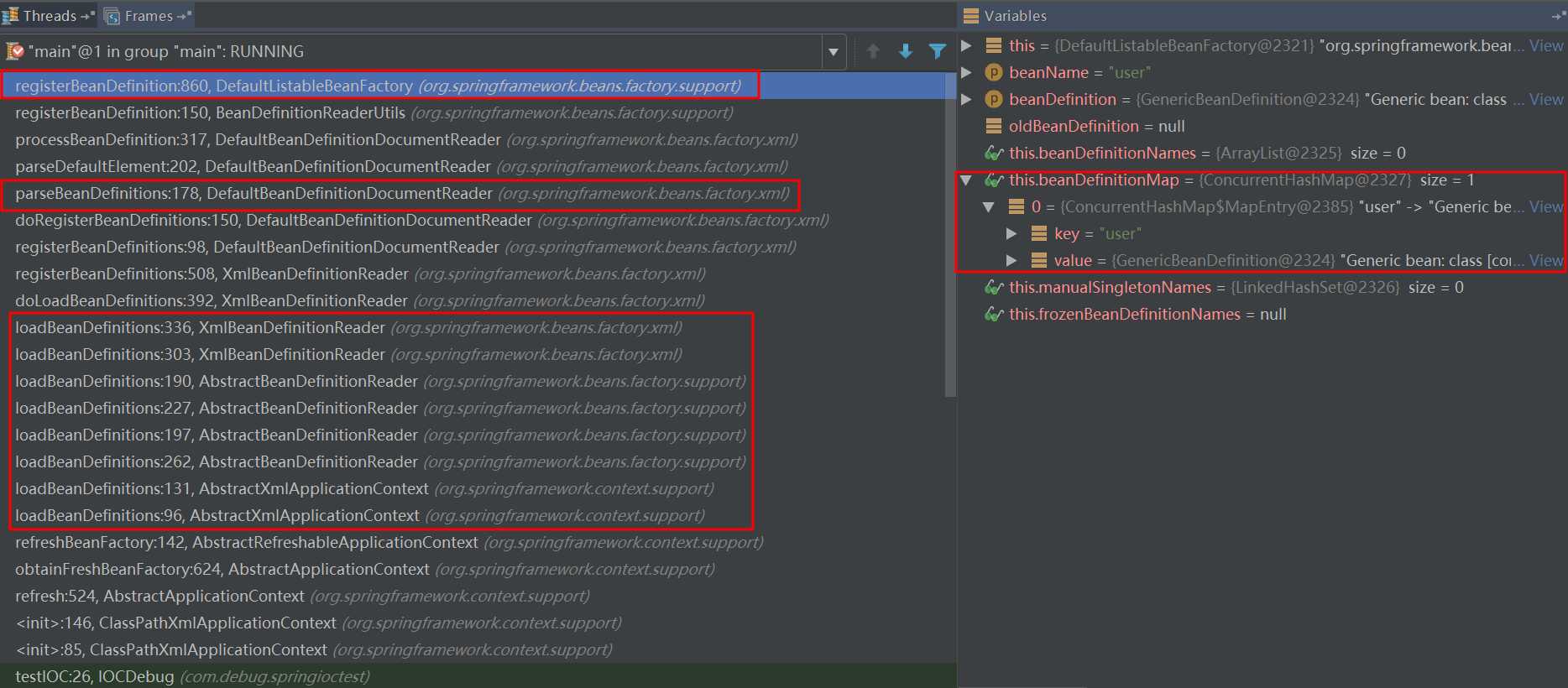
通过程序调用链可知:
(1)导入bean大致分为三个阶段:①导入bean(loadBeanDefinitions);②解析bean(parseBeanDefinition);③注册bean(registerBeanDefinition)。
(2)最终bean是存储在beanDefinitionMap中:键为类名(beanName),值为GenericBeanDefinition(BeanDefinition)。
下面对导入bean的三个阶段进行分析。
通过上述调用链,先整理出在导入bean过程中所涉及的类和相关方法。
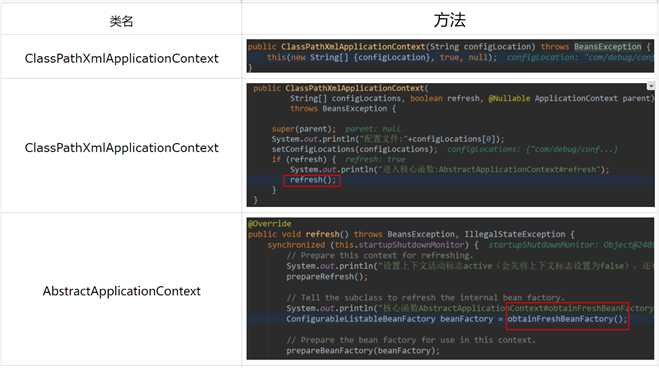
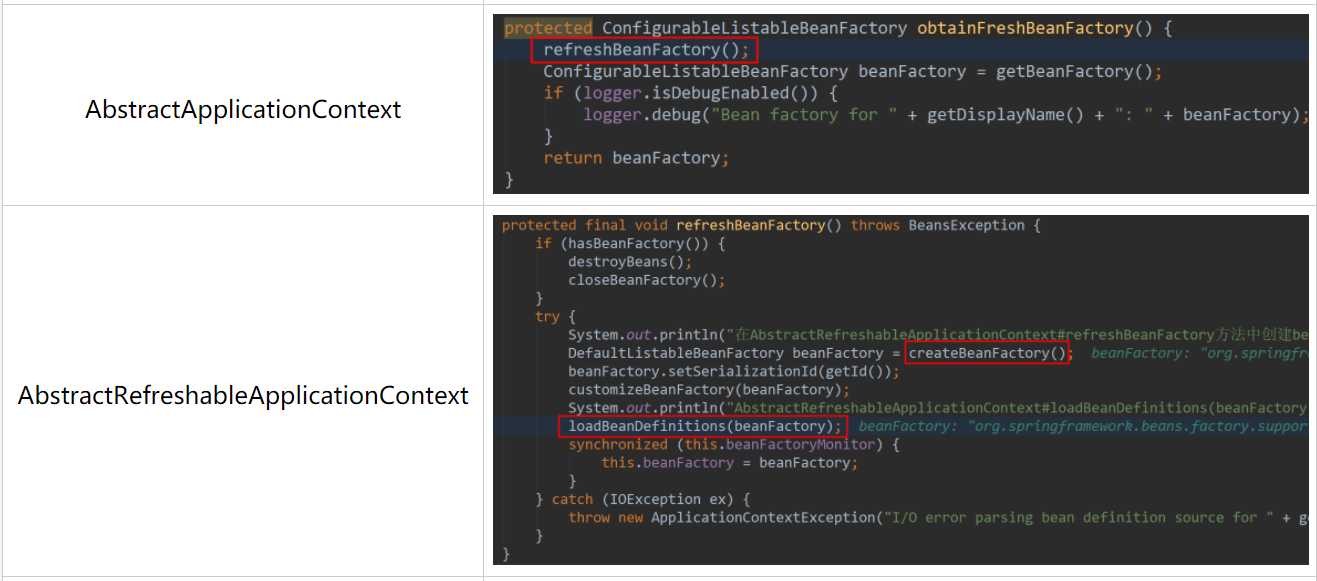
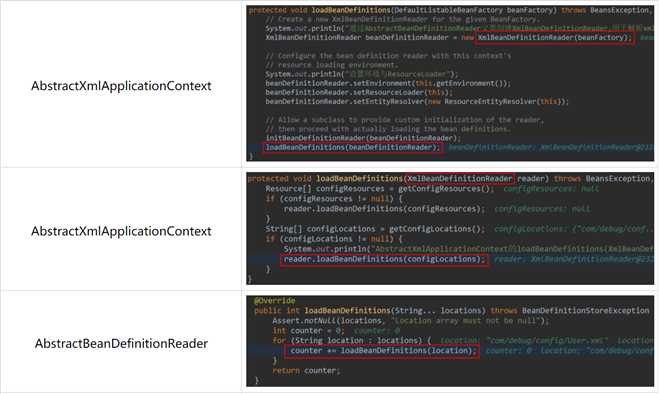
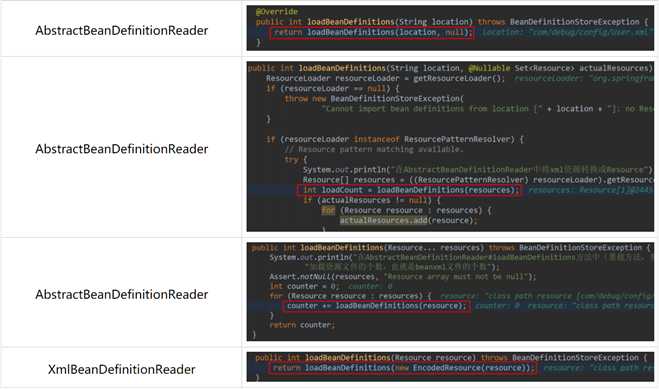
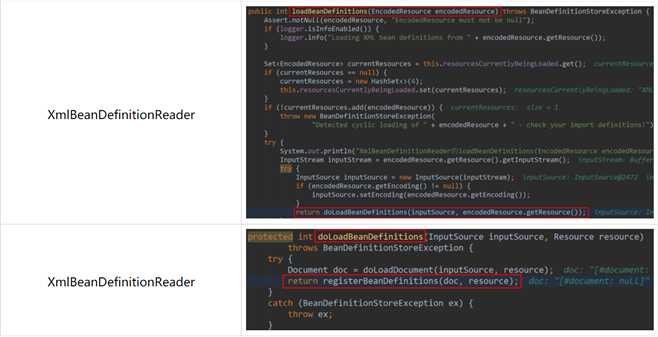
通过上表可以知道,在导入bean阶段主要涉及如下几个类(根据调用顺序):
①ClassPathXmlApplicationContext;②AbstractApplicationContext;
③AbstractRefreshableApplicationContext;④AbstractXmlApplicationContext;
⑤AbstractBeanDefinitionReader;⑥XmlBeanDefinitionReader。
根据类名就可以猜测出①②③④为继承关系,事实的确如此。其继承关系通过ClassPathXmlApplicationContext继承关系图可知:
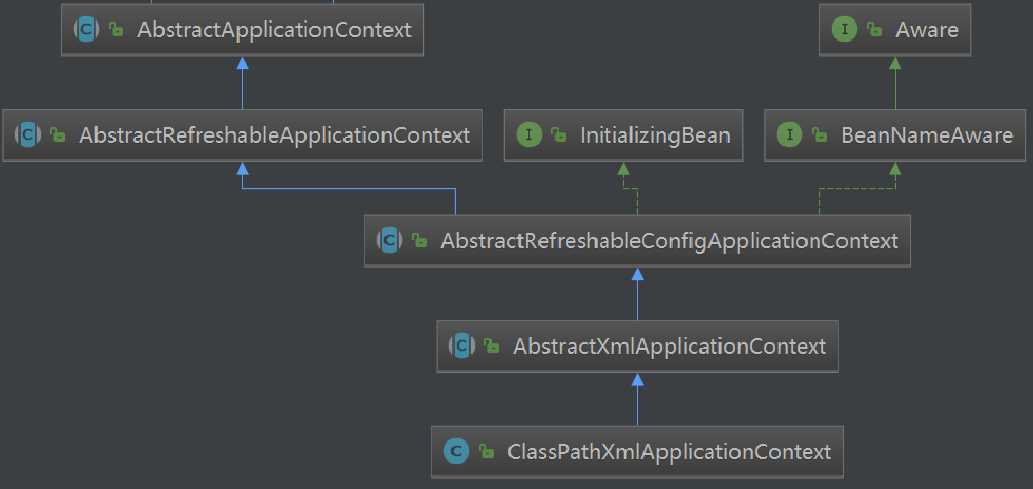
⑤⑥也为继承关系,其继承关系如下:
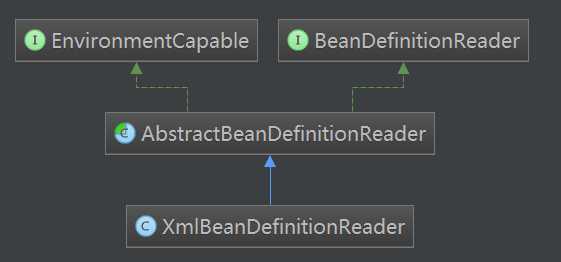
通过上面对bean导入阶段大致流程的梳理,应该对bean导入阶段有了大体的认识,下面对该阶段源码进行分析(按上面程序调用链顺序)。
ClassPathXmlApplicationContext构造函数,具体代码如下:
1 public ClassPathXmlApplicationContext( 2 String[] configLocations, boolean refresh, @Nullable ApplicationContext parent) 3 throws BeansException { 4 5 super(parent); 6 System.out.println("配置文件:"+configLocations[0]); 7 setConfigLocations(configLocations); //配置xml文件资源 8 if (refresh) { 9 System.out.println("进入核心函数:AbstractApplicationContext#refresh"); 10 refresh(); 11 } 12 }
这段代码比较好理解主要就是设置xml文件资源,将xml文件的路径保存下来,供后面使用。
第7行代码调用的是AbstractRefreshableConfigApplicationContext的setConfigLocations函数,该函数功能简单:设置xml文件资源,具体代码如下:
1 /** 2 * Set the config locations for this application context. 3 * <p>If not set, the implementation may use a default as appropriate. 4 */ 5 public void setConfigLocations(@Nullable String... locations) { 6 if (locations != null) { 7 Assert.noNullElements(locations, "Config locations must not be null"); 8 this.configLocations = new String[locations.length]; 9 for (int i = 0; i < locations.length; i++) { 10 this.configLocations[i] = resolvePath(locations[i]).trim(); //解析xml路径,并存入configLocations中 11 } 12 } 13 else { 14 this.configLocations = null; 15 } 16 }
第10行代码refresh()为整个IOC流程的入口,这里调用的是AbstractApplicationContext的refresh方法,具体代码如下:
1 public void refresh() throws BeansException, IllegalStateException { 2 synchronized (this.startupShutdownMonitor) { 3 // Prepare this context for refreshing. 4 System.out.println("设置上下文活动标志active(会先将上下文标志设置为true),还有进行一些环境配置。"); 5 prepareRefresh(); 6 7 // Tell the subclass to refresh the internal bean factory. 8 System.out.println("核心函数AbstractApplicationContext#obtainFreshBeanFactory,功能解析xml,创建BeanFactory"); 9 ConfigurableListableBeanFactory beanFactory = obtainFreshBeanFactory(); 10 11 // Prepare the bean factory for use in this context. 12 prepareBeanFactory(beanFactory); 13 14 try { 15 // Allows post-processing of the bean factory in context subclasses. 16 postProcessBeanFactory(beanFactory); 17 18 // Invoke factory processors registered as beans in the context. 19 invokeBeanFactoryPostProcessors(beanFactory); 20 21 // Register bean processors that intercept bean creation. 22 registerBeanPostProcessors(beanFactory); 23 24 // Initialize message source for this context. 25 initMessageSource(); 26 27 // Initialize event multicaster for this context. 28 initApplicationEventMulticaster(); 29 30 // Initialize other special beans in specific context subclasses. 31 onRefresh(); 32 33 // Check for listener beans and register them. 34 registerListeners(); 35 36 // Instantiate all remaining (non-lazy-init) singletons. 37 //该函数中会对bean进行初始化,利用反射技术。 38 finishBeanFactoryInitialization(beanFactory); 39 40 // Last step: publish corresponding event. 41 finishRefresh(); 42 } 43 44 catch (BeansException ex) { 45 if (logger.isWarnEnabled()) { 46 logger.warn("Exception encountered during context initialization - " + 47 "cancelling refresh attempt: " + ex); 48 } 49 50 // Destroy already created singletons to avoid dangling resources. 51 destroyBeans(); 52 53 // Reset ‘active‘ flag. 54 cancelRefresh(ex); 55 56 // Propagate exception to caller. 57 throw ex; 58 } 59 60 finally { 61 // Reset common introspection caches in Spring‘s core, since we 62 // might not ever need metadata for singleton beans anymore... 63 resetCommonCaches(); 64 } 65 } 66 }
注:该方法为同步方法;主要关注:①obtainFreshBeanFactory;②finishBeanFactoryInitialization。①方法会进行bean的注入;②方法会利用反射实例化bean。
第5行prepareRefresh函数功能比较简单:设置相关标志(将active设置为true),初始化一些数据。
重点第9行obtainFreshBeanFactory函数生成beanFactory工厂,具体代码如下:
1 protected ConfigurableListableBeanFactory obtainFreshBeanFactory() { 2 refreshBeanFactory(); 3 ConfigurableListableBeanFactory beanFactory = getBeanFactory(); 4 if (logger.isDebugEnabled()) { 5 logger.debug("Bean factory for " + getDisplayName() + ": " + beanFactory); 6 } 7 return beanFactory; 8 }
注意这里执行完refreshBeanFactory后就会返回beanFactory,关键函数refreshBeanFactory刷新beanFactory,这里会调用AbstractRefreshableApplicationContext中的refreshBeanFactory方法,具体代码如下:
1 protected final void refreshBeanFactory() throws BeansException { 2 if (hasBeanFactory()) { 3 destroyBeans(); 4 closeBeanFactory(); 5 } 6 try { 7 System.out.println("在AbstractRefreshableApplicationContext#refreshBeanFactory方法中创建beanFactory"); 8 DefaultListableBeanFactory beanFactory = createBeanFactory(); 9 beanFactory.setSerializationId(getId()); 10 customizeBeanFactory(beanFactory); 11 System.out.println("AbstractRefreshableApplicationContext#loadBeanDefinitions(beanFactory)关键函数,载入bean定义"); 12 loadBeanDefinitions(beanFactory); 13 synchronized (this.beanFactoryMonitor) { 14 this.beanFactory = beanFactory; 15 } 16 } catch (IOException ex) { 17 throw new ApplicationContextException("I/O error parsing bean definition source for " + getDisplayName(), ex); 18 } 19 }
分析:
①第2行:首先判断是否存在beanFactory,如果存在则销毁bean,并关闭beanfactory。
②第8行:创建beanFactory。
③第12行:导入bean。
关注第8行创建beanFactory,该函数会调用AbstractRefreshableApplicationContext中的createBeanFactory方法,具体代码如下:
1 protected DefaultListableBeanFactory createBeanFactory() { 2 System.out.println("new一个DefaultListableBeanFactory,需先判断是否存在内部的BeanFactory实例"); 3 return new DefaultListableBeanFactory(getInternalParentBeanFactory()); 4 }
这里直接new一个DefaultListableBeanFactory实例,这里会先判断是否有父工厂,在DefaultListableBeanFactory的构造函数中会调用其父类AbstractAutowireCapableBeanFactory的构造函数,在其构造函数中需要进行关注下:
1 public AbstractAutowireCapableBeanFactory() { 2 super(); 3 ignoreDependencyInterface(BeanNameAware.class); 4 ignoreDependencyInterface(BeanFactoryAware.class); 5 ignoreDependencyInterface(BeanClassLoaderAware.class); 6 System.out.println("AbstractAutowireCapableBeanFactory构造函数中,忽略实现接口BeanNameAware.class/BeanFactoryAware.class/BeanClassLoaderAware.class类的自动装配功能"); 7 }
这里会忽略实现BeanNameAware/BeanFactoryAware/BeanClassLoaderAware接口类的自动装配功能。
在实例化DefaultListableBeanFactory后,会对beanFactory进行一些设置,在customizeBeanFactory函数中:
1 protected void customizeBeanFactory(DefaultListableBeanFactory beanFactory) { 2 if (this.allowBeanDefinitionOverriding != null) { 3 beanFactory.setAllowBeanDefinitionOverriding(this.allowBeanDefinitionOverriding); 4 } 5 if (this.allowCircularReferences != null) { 6 beanFactory.setAllowCircularReferences(this.allowCircularReferences); 7 } 8 }
注:这里设置是否可以对BeanDefinition进行覆盖,是否允许循环依赖属性。
接下来重点函数loadBeanDefinitions,这里转向AbstractXmlApplicationContext中的loadBeanDefinitions函数,具体代码如下:
1 protected void loadBeanDefinitions(DefaultListableBeanFactory beanFactory) throws BeansException, IOException { 2 // Create a new XmlBeanDefinitionReader for the given BeanFactory. 3 System.out.println("通过AbstractBeanDefinitionReader父类创建XmlBeanDefinitionReader,用于解析xml文件的bean"); 4 XmlBeanDefinitionReader beanDefinitionReader = new XmlBeanDefinitionReader(beanFactory); 5 6 // Configure the bean definition reader with this context‘s 7 // resource loading environment. 8 System.out.println("设置环境与ResourceLoader"); 9 beanDefinitionReader.setEnvironment(this.getEnvironment()); 10 beanDefinitionReader.setResourceLoader(this); 11 beanDefinitionReader.setEntityResolver(new ResourceEntityResolver(this)); 12 13 // Allow a subclass to provide custom initialization of the reader, 14 // then proceed with actually loading the bean definitions. 15 initBeanDefinitionReader(beanDefinitionReader); 16 loadBeanDefinitions(beanDefinitionReader); 17 }
分析:
①第4行创建XmlBeanDefinitionReader,是在AbstractBeanDefinitionReader中创建的,传入beanFactory对象。
②9-11行对beanDefinitionReader设置环境、资源导入器、实体解析器。
③第15行注释已经写得很清楚了,允许子类自定义实现beanDefinitionReader方法。
④继续调用loadBeanDefinitions,传入beanDefinitionReader。
此时loadBeanDefinitions函数仍然调用的是AbstractXmlApplicationContext中的方法:
1 protected void loadBeanDefinitions(XmlBeanDefinitionReader reader) throws BeansException, IOException { 2 Resource[] configResources = getConfigResources(); 3 if (configResources != null) { 4 reader.loadBeanDefinitions(configResources); 5 } 6 String[] configLocations = getConfigLocations(); 7 if (configLocations != null) { 8 System.out.println("AbstractXmlApplicationContext的loadBeanDefinitions(XmlBeanDefinitionReader reader),导入xml资源"); 9 reader.loadBeanDefinitions(configLocations); 10 } 11 }
分析:
这里根据资源类型走不同分支,由于我们前面已经设置了configLocation,所以这里走到第9行处。
由于创建beanDefinitionReader是在AbstractBeanDefinitionReader中实现,因此转向AbstractBeanDefinitionReader的loadBeanDefinitions:
1 @Override 2 public int loadBeanDefinitions(String... locations) throws BeanDefinitionStoreException { 3 Assert.notNull(locations, "Location array must not be null"); 4 int counter = 0; 5 for (String location : locations) { 6 counter += loadBeanDefinitions(location); 7 } 8 return counter; 9 }
循环资源文件进行导入(这里会多次调用loadBeanDefinitions方法,注意方法入参),继续其loadBeanDefinitions方法,注意方法入参不同,最终转向的loadBeanDefinitions方法代码如下:
1 public int loadBeanDefinitions(String location, @Nullable Set<Resource> actualResources) throws BeanDefinitionStoreException { 2 ResourceLoader resourceLoader = getResourceLoader(); 3 if (resourceLoader == null) { 4 throw new BeanDefinitionStoreException( 5 "Cannot import bean definitions from location [" + location + "]: no ResourceLoader available"); 6 } 7 8 if (resourceLoader instanceof ResourcePatternResolver) { 9 // Resource pattern matching available. 10 try { 11 System.out.println("在AbstractBeanDefinitionReader中将xml资源转换成Resource"); 12 Resource[] resources = ((ResourcePatternResolver) resourceLoader).getResources(location); 13 int loadCount = loadBeanDefinitions(resources); 14 if (actualResources != null) { 15 for (Resource resource : resources) { 16 actualResources.add(resource); 17 } 18 } 19 if (logger.isDebugEnabled()) { 20 logger.debug("Loaded " + loadCount + " bean definitions from location pattern [" + location + "]"); 21 } 22 return loadCount; 23 } 24 catch (IOException ex) { 25 throw new BeanDefinitionStoreException( 26 "Could not resolve bean definition resource pattern [" + location + "]", ex); 27 } 28 } 29 else { 30 // Can only load single resources by absolute URL. 31 Resource resource = resourceLoader.getResource(location); 32 int loadCount = loadBeanDefinitions(resource); 33 if (actualResources != null) { 34 actualResources.add(resource); 35 } 36 if (logger.isDebugEnabled()) { 37 logger.debug("Loaded " + loadCount + " bean definitions from location [" + location + "]"); 38 } 39 return loadCount; 40 } 41 }
分析:
①第2行:取出资源导入器,为下面将xml配置文件转换成Resource数组做准备。
②第13行:由于将xml配置文件转换成了Resource数组,这里继续调用AbstractBeanDefinitionReader的loadBeanDefinitions方法(注意入参):
1 public int loadBeanDefinitions(Resource... resources) throws BeanDefinitionStoreException { 2 System.out.println("在AbstractBeanDefinitionReader#loadBeanDefinitions方法中(参数为Resource)得到" + 3 "加载资源文件的个数,也就是beanxml文件的个数"); 4 Assert.notNull(resources, "Resource array must not be null"); 5 int counter = 0; 6 for (Resource resource : resources) { 7 counter += loadBeanDefinitions(resource); 8 } 9 return counter; 10 }
注意在第7行处,这里要调用子类的方法了,具体调用XmlBeanDefinitionReader的loadBeanDefinitions方法:
1 /** 2 * Load bean definitions from the specified XML file. 3 * @param resource the resource descriptor for the XML file 4 * @return the number of bean definitions found 5 * @throws BeanDefinitionStoreException in case of loading or parsing errors 6 */ 7 @Override 8 public int loadBeanDefinitions(Resource resource) throws BeanDefinitionStoreException { 9 return loadBeanDefinitions(new EncodedResource(resource)); 10 } 11 12 /** 13 * Load bean definitions from the specified XML file. 14 * @param encodedResource the resource descriptor for the XML file, 15 * allowing to specify an encoding to use for parsing the file 16 * @return the number of bean definitions found 17 * @throws BeanDefinitionStoreException in case of loading or parsing errors 18 */ 19 public int loadBeanDefinitions(EncodedResource encodedResource) throws BeanDefinitionStoreException { 20 Assert.notNull(encodedResource, "EncodedResource must not be null"); 21 if (logger.isInfoEnabled()) { 22 logger.info("Loading XML bean definitions from " + encodedResource.getResource()); 23 } 24 25 Set<EncodedResource> currentResources = this.resourcesCurrentlyBeingLoaded.get(); 26 if (currentResources == null) { 27 currentResources = new HashSet<>(4); 28 this.resourcesCurrentlyBeingLoaded.set(currentResources); 29 } 30 if (!currentResources.add(encodedResource)) { 31 throw new BeanDefinitionStoreException( 32 "Detected cyclic loading of " + encodedResource + " - check your import definitions!"); 33 } 34 try { 35 System.out.println("XmlBeanDefinitionReader的loadBeanDefinitions(EncodedResource encodedResource)中间Resource转化成InputStream流,进行读取操作"); 36 InputStream inputStream = encodedResource.getResource().getInputStream(); 37 try { 38 InputSource inputSource = new InputSource(inputStream); 39 if (encodedResource.getEncoding() != null) { 40 inputSource.setEncoding(encodedResource.getEncoding()); 41 } 42 return doLoadBeanDefinitions(inputSource, encodedResource.getResource()); 43 } 44 finally { 45 inputStream.close(); 46 } 47 } 48 catch (IOException ex) { 49 throw new BeanDefinitionStoreException( 50 "IOException parsing XML document from " + encodedResource.getResource(), ex); 51 } 52 finally { 53 currentResources.remove(encodedResource); 54 if (currentResources.isEmpty()) { 55 this.resourcesCurrentlyBeingLoaded.remove(); 56 } 57 } 58 }
分析:
①这里将Resource对象包装成了EncodedResource对象,注意第25行使用了ThreadLocal来避免线程安全问题。
②第36行:获取了一个输入流,对xml文件进行操作,接下来开始导入bean,转向XmlBeanDefinitionReader的doLoadBeanDefinitions方法:
1 protected int doLoadBeanDefinitions(InputSource inputSource, Resource resource) 2 throws BeanDefinitionStoreException { 3 try { 4 Document doc = doLoadDocument(inputSource, resource); 5 return registerBeanDefinitions(doc, resource); 6 } 7 catch (...) 8 }
至此,导入bean阶段完成,通过这么长的调用链其实主要就是将xml配置文件转换成流,为下一步解析和注册bean做准备。
下面给出bean导入阶段的大致时序图:
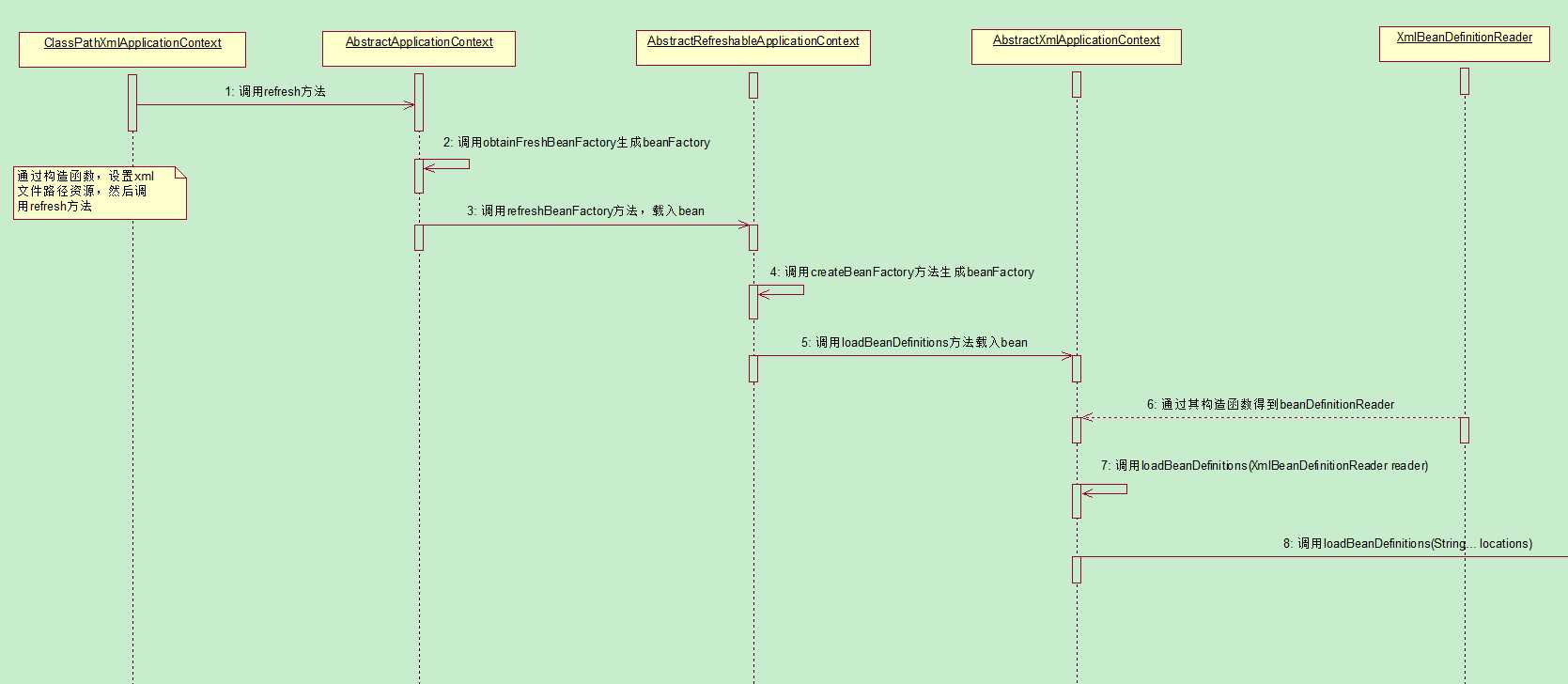
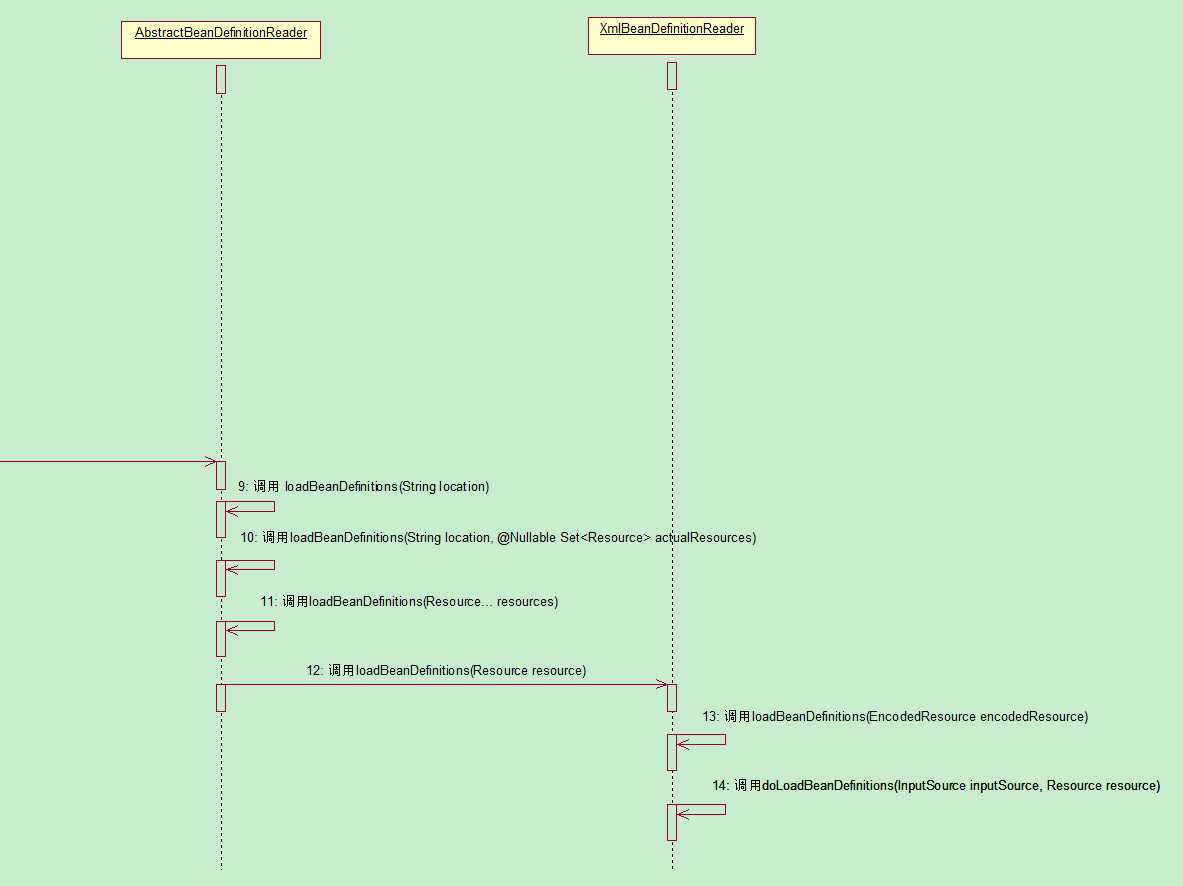
至此导入bean阶段大致分析完成,该阶段总的来说还是比较简单,下面将对解析bean阶段进行分析。
by Shawn Chen,2018.11.24日,晚。
标签:temp 类的方法 获取 blank 核心 ini 阶段 esc enabled
原文地址:https://www.cnblogs.com/morewindows0/p/10004293.html